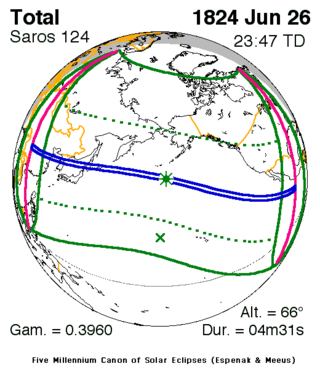
KNOWPIA
WELCOME TO KNOWPIA
Summary
A total solar eclipse occurred on June 26, 1824. A solar eclipse occurs when the Moon passes between Earth and the Sun, thereby totally or partly obscuring the image of the Sun for a viewer on Earth. A total solar eclipse occurs when the Moon's apparent diameter is larger than the Sun's, blocking all direct sunlight, turning day into darkness. Totality occurs in a narrow path across Earth's surface, with the partial solar eclipse visible over a surrounding region thousands of kilometres wide. Totality was visible across parts of China and Japan, with a partial eclipse across much of North America near sunset.
| Solar eclipse of June 26, 1824 | |
|---|---|
 Map | |
| Type of eclipse | |
| Nature | Total |
| Gamma | 0.396 |
| Magnitude | 1.0578 |
| Maximum eclipse | |
| Duration | 271 s (4 min 31 s) |
| Coordinates | 46°36′N 171°24′W / 46.6°N 171.4°W |
| Max. width of band | 207 km (129 mi) |
| Times (UTC) | |
| Greatest eclipse | 23:46:33 |
| References | |
| Saros | 124 (44 of 73) |
| Catalog # (SE5000) | 9101 |
Related eclipses edit
It is a part of solar Saros 124.
References edit
- NASA chart graphics
- Googlemap
- NASA Besselian elements


